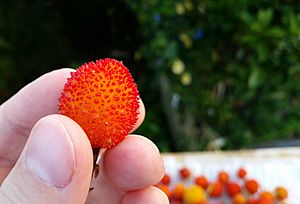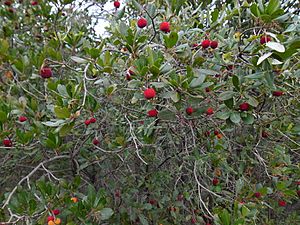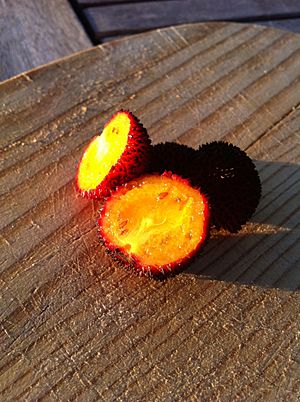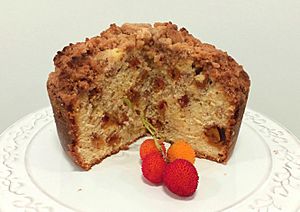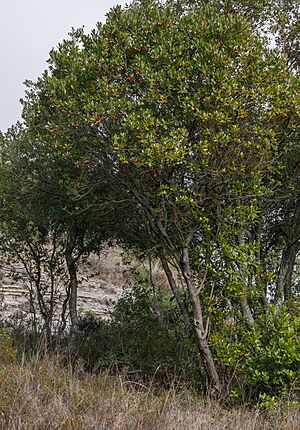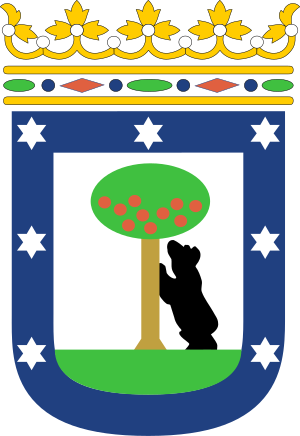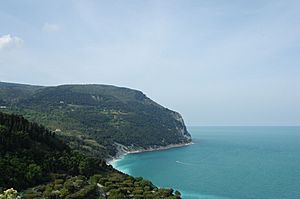Strawberry tree facts for kids
Quick facts for kids Strawberry tree |
|
|---|---|
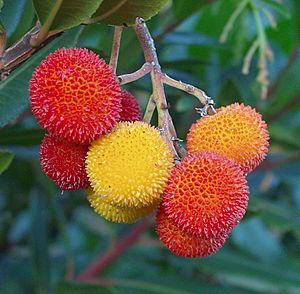 |
|
| Fruit of Arbutus unedo | |
| Conservation status | |
| Scientific classification | |
| Genus: |
Arbutus
|
| Species: |
unedo
|
 |
|
Distribution map. Explanation:
|
|
The Strawberry Tree, also known as Arbutus unedo, is a type of evergreen shrub or small tree. It belongs to the flowering plant family called Ericaceae. This tree is originally from the Mediterranean region and western Europe, reaching as far north as western France and Ireland. In Ireland, where it grows in the southwest and northwest, it is sometimes called the "Irish strawberry tree," "cain apple," or "Killarney strawberry tree." The name "cain apple" comes from the Irish word caithne.
Even though it's called the "strawberry tree," it's not closely related to the common strawberry plant you might know.
Contents
About the Strawberry Tree
What it Looks Like

The strawberry tree usually grows to be about 5 to 10 meters (16 to 33 feet) tall. Sometimes, it can even reach 15 meters (49 feet) with a trunk up to 80 centimeters (31 inches) wide. It can grow in many different climates, especially those that don't get too cold.
Its leaves are dark green and shiny. They are about 5 to 10 centimeters (2 to 4 inches) long and 2 to 3 centimeters (0.8 to 1.2 inches) wide. The edges of the leaves are serrated, meaning they have small teeth-like points.
The flowers are white, but sometimes they can be pale pink. They are shaped like bells and are about 4 to 6 millimeters (0.16 to 0.24 inches) across. These flowers grow in bunches of 10 to 30 and appear in the autumn. Bees help pollinate the flowers, and they have a light, sweet smell.
The fruit is a red berry with a rough surface, about 1 to 2 centimeters (0.4 to 0.8 inches) wide. It takes about 12 months for the fruit to ripen, so you'll see ripe fruit on the tree at the same time as the new flowers in autumn. The fruit is edible and tastes sweet when it's fully red. Birds often eat the fruit, which helps spread the seeds.
The name unedo comes from an old saying by Pliny the Elder, a Roman writer. He supposedly said "unum tantum edo," which means "I eat only one." People aren't sure if he meant the fruit was so good he could only eat one, or if it was not very interesting, so he only ate one.
Where it Grows
The strawberry tree is common in the Mediterranean region. You can find it in countries like Portugal, Spain, France, Italy, Greece, and Turkey. It also grows in North Africa (Algeria, Morocco, Libya, Tunisia) and parts of the Middle East (Lebanon, Syria, Palestine, Israel). Beyond the Mediterranean, it grows in western France, Albania, Bulgaria, and even in southwestern and northwestern Ireland.
The trees in Ireland are special because they are the most northern group in the world. They are a leftover from a time when the climate was warmer than it is today. A type of strawberry tree with red flowers was found growing wild in Ireland in 1835.
Growing Strawberry Trees
The strawberry tree is quite easy to grow and can adapt to many different climates. Once it's settled, it can handle dry weather, frost, shade, and even salty conditions. However, if there are long dry summers or frosts during flowering, the tree might produce fewer fruits.
It's a popular plant in places like California because it naturally likes dry summers. It also grows well in the cooler, wetter summers of western Ireland and England. Some common problems for the tree include small insects like scales and thrips, and diseases like root rot.
Unlike many plants in its family, the strawberry tree can grow well in soils that are more basic (limy), though it prefers slightly acidic soils.
The amount of fruit a tree produces can vary a lot depending on the weather. This might be why it's not grown on a large scale. Scientists are still working on finding the best types of strawberry trees for fruit production.
How to Grow New Trees
You can grow new strawberry trees from seed, by layering (bending a branch to root in the soil), or from cuttings (taking a piece of the plant to grow roots).
- Seeds: Seeds need to be kept cold for about a month before planting. Then, soak them in warm water for 5 to 6 days to help them sprout. Young plants are delicate and need careful attention in their first year. Not many seeds usually sprout, sometimes less than 20%.
- Layering: This method can take up to two years, but it usually works well.
- Cuttings: You can take a cutting about 15 to 20 centimeters (6 to 8 inches) long from a mature branch in late autumn or early winter. However, cuttings don't always root successfully.
Uses of the Strawberry Tree
Food and Drink
The fruits of the strawberry tree are rich in sugars (about 40%) and helpful antioxidants like vitamin C and beta-carotene. They also contain healthy fats like omega-3 and omega-6 fatty acids. You can eat the fruit fresh, but it bruises easily, making it hard to transport.
Because of this, the fruits are often used to make jam, marmalades, yogurt, and alcoholic beverages. In Portugal, a strong brandy called medronho is made from the fruit. In Albania, a traditional drink called rakia is made from the fruit.
The flowers are important for bees, and the honey they make from strawberry tree flowers has a slightly bitter taste, which some people consider a special treat.
Traditional Medicine
For a long time, people have used the leaves of the strawberry tree in traditional medicine. They make a decoction (a strong tea) from the leaves. This drink is believed to help with things like digestion, removing excess water from the body, and fighting infections. It has also been used for rheumatism and to help with high blood pressure and diabetes.
The leaves are full of flavonols, which are powerful antioxidants. These are best extracted by making a decoction.
Helping the Environment
The strawberry tree is useful for more than just its fruit. It can help restore damaged environments and prevent areas from turning into deserts. Since it's a "pioneer plant" (one of the first to grow in new or disturbed areas) and can grow in poor soils, it's great for many situations.
- Food for Wildlife: Its flowers provide lots of nectar and pollen for bees, and its fruits are a food source for birds.
- Windbreaks: Because it can handle salt and stays green all year, it's a good choice for creating wind barriers near the sea.
- Fire Resistance: The strawberry tree can regrow after a fire. It can also help stop the spread of fires in areas with many pine or eucalyptus trees.
- Shelter: Its thick leaves provide shelter for insects and small animals, especially in winter.
- Soil Health: Its deep root system helps keep the soil stable and prevents erosion.
Other Uses
- Wood: The wood of the strawberry tree is quite hard. It's good for firewood and making things like pipes. Since the tree doesn't usually grow straight, its wood isn't often used for building.
- Ornamental Plant: People also grow the strawberry tree just because it looks beautiful. Its flowers and fruits are lovely, and it's interesting that they appear on the tree at the same time. Since it's an evergreen, it adds color to gardens and public spaces all year round.
History and Symbols
Ancient Times
The strawberry tree was well-known in ancient times because of its Mediterranean home, pretty leaves, and the striking sight of its fruit and flowers together. Ancient writers like Theophrastos and Pedanios Dioscorides wrote about it. Pliny the Elder even suggested it shouldn't be planted near beehives because it made the honey taste bitter.
The name of the Italian mountain Mount Conero comes from the Greek word komaròs, which means strawberry tree. This tree is very common on the mountain's slopes. Mount Conero is an important landmark for sailors in the Adriatic Sea.
Spain

The famous painting The Garden of Earthly Delights by Hieronymus Bosch was once called "The Painting of the Strawberry Tree" in a Spanish inventory.
The strawberry tree is part of the Coat of arms of Madrid, the capital city of Spain. The symbol shows a bear eating the fruit of a madroño (strawberry tree). You can see a statue of this bear and tree in the center of Madrid. This image appears on city crests, taxis, and other city items.
Italy
In the 19th century, during the time when Italy was becoming a unified country, the strawberry tree started to be seen as a national symbol. This is because its autumn colors – green leaves, white flowers, and red berries – reminded people of the flag of Italy.
Because of this, the poet Giovanni Pascoli wrote a poem about the strawberry tree. He connected it to an old Roman story from the Aeneid, where a hero named Pallas was laid on strawberry tree branches after he died. Pascoli saw the colors of the tree as a sign of the Italian flag and thought of Pallas as the first "national cause martyr."
Here's a part of Pascoli's poem:
O verde albero italico, il tuo maggio
è nella bruma: s'anche tutto muora,
tu il giovanile gonfalon selvaggio
spieghi alla bora—Giovanni Pascoli
Oh green Italian tree, your May month
is in the mist: if everything die,
you, the youthful wild banner
unfold to the northern wind



